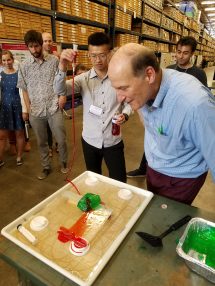Analog Modeling of Tectonic Processes
November 20, 2017

Studying tectonic processes presents geoscientists with a multitude of difficulties, but none of the challenges are more daunting than dealing with the scale of the science: tectonic processes are large and take place over a long period of time.
Given these issues, models can be a very effective way of understanding some of the processes governing tectonic deformation.
Analog, or physical, models contribute substantially to the development of new tectonic concepts, as well as benchmarking numerical models. Still, the analog modeling community is dispersed and small, and its interaction and collaboration with the numerical modeling community is limited.
The National Science Foundation sponsored an international Analog Modeling of Tectonic Processes workshop at the Bureau of Economic Geology in May 2017 to bring the two modeling communities together. Bureau researcher and workshop co-organizer Tim Dooley points to the success of a session where the attendees ran an analog and a numerical model of an extensional rift system.
The results stimulated discussions on the strengths and limitations of both approaches, as well as ways to increase collaboration between the two scientific modeling groups.
“This hands-on approach during the workshop led to a direct exchange of ideas and facilitated networking between the different communities,”
Dooley said. The group visiting the bureau consisted of about 50 modelers from six countries and included early-, mid- and late-career geoscientists. The three-day workshop included 10 oral presentations on topics such as the application of model results to field and seismic data, different experimental techniques, and scaling and reproducibility issues. Some 22 posters and two teaching examples of modeling methods were presented.
The workshop concluded with a discussion where participants agreed that a better system was needed to exchange teaching material on analog models in classrooms, and that there is an ongoing need for a system or database to store and exchange model results, as well as a database of different model materials.
Back to the Newsletter